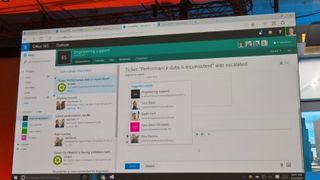Office isn't just about documents – it'll help order your morning coffee
And all manner of other clever tricks…
Convenience of Connectors
The Connectors feature means add-ins don't have to wait for the user to click on something. "We're adding support for webhooks [a way of sending information between cloud services] so add-ins can respond in real-time to changes to data." You can already use Connectors with Groups today, so when someone posts a question on Stack Overflow, or asks for a new feature on User Voice, or checks in code on GitHub or submits a support request on Zendesk, that information can show up in a Group automatically.

Instead of just getting a message from a service like Salesforce through a connector, you can reply to it and take an action. That's a very basic first step towards the conversations that Microsoft CEO Satya Nadella talked about at the Build conference last week, and at the moment it's much more similar to the way Slack bots can add information to a channel automatically.
The list of 52 services includes development tools like Subversion, marketing tools like MailChimp, admin services like PagerDuty and Pivotal Tracker and a good many developer services like Asana, Crashlytics, Subversion and Bugsnag.
Howard said Microsoft is looking at where else Connectors could post information apart from Groups – some people might prefer to see it in their inbox instead, for example.

Control aplenty
Because add-ins get to see the information in your Office 365 tenant or Outlook account, Microsoft is giving companies plenty of controls. "Admins can deploy add-ins to users so when you log in to Office you get the functionality your admin has picked for you to get your work done," said Howard.
"We will also have more tools for businesses to give the admins control over what add-ins can be used in their organisation. Tenant admins have full control of what add-ins have access to their data; if you trust a software vendor you can grant access and rescind it later. The user has the same control when they connect to their own data. An app has to request what level of data it wants to access and users can remove access as well."
The Office add-ins that your business might already be using today will carry on working for a long time, he promised. "There is a huge amount of intellectual property and business processes that run on those and we won't be removing support for that functionality any time soon."
Are you a pro? Subscribe to our newsletter
Sign up to the TechRadar Pro newsletter to get all the top news, opinion, features and guidance your business needs to succeed!
But don't expect to see them work unchanged on other versions of Office. "The new add-in model is the way we can take functionality across other platforms in a more seamless way," said Howard – they'll have to be rewritten, but then they'll work in Office on more and more devices.
Mary (Twitter, Google+, website) started her career at Future Publishing, saw the AOL meltdown first hand the first time around when she ran the AOL UK computing channel, and she's been a freelance tech writer for over a decade. She's used every version of Windows and Office released, and every smartphone too, but she's still looking for the perfect tablet. Yes, she really does have USB earrings.
